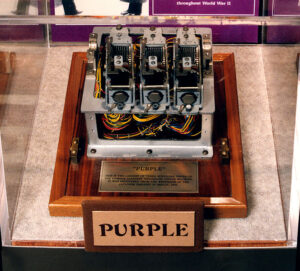As early as 1934 Army Signal Corps cryptanalysts were deciphering certain Japanese diplomatic codes—a process which was given the code name MAGIC. These diplomatic codes were transmitted on a machine, known to U.S. cryptographers as PURPLE. The PURPLE machine consisted of two electronic typewriters separated by a plugboard and a box that contained the encryption rotors. Similar to the Enigma machine, PURPLE would not encipher any letter to itself. (An ‘a’ would never be encrypted as an ‘a’.)
William Friedman, without ever seeing the device and with the assistance of the SIS (the Army’s Signals Intelligence Section), reconstructed a purple machine in 1940. For the next 18 months, cryptanalysts experimented with the wires and switches of the machine until they broke the code. Japanese officials only used the PURPLE enciphering machine to transmit diplomatic messages to its embassies. Between December 6th and 7th, 1941, Tokyo sent the Japanese embassy in Washington, D.C. a fourteen-part message concerning the cessation of the ongoing negotiations and severing of diplomatic relations. On November 26, 1941 Secretary of State Cordell Hull responded to the latest Japanese diplomatic offer by “washing his hands of it.” (Stimson and Bundy, On Active Service, 389) Marshall, knowing that without a settlement “things would automatically happen”, sent out warnings to all their Pacific commanders, incorrectly assuming that the blow would fall on the Philippines.
 Marshall later testified in 1944: “We anticipated, beyond a doubt, a Japanese movement in Indo-China and the Gulf of Siam, and against the Malay Peninsula. We anticipated also an assault on the Philippines. We did not, so far as I recall, anticipate an attack on Hawaii; the reason being that we thought, with the addition of more modern planes, that the defenses there would be sufficient to make it extremely hazardous for the Japanese to attempt any such an attack.” (Marshall testimony, August 7, 1944, Joint Committee on the Investigation of the Pearl Harbor Attack, Hearings . . . pt. 27, Proceedings of the Army Pearl Harbor Board [Washington: GPO, 1946], p. 14.)
Marshall later testified in 1944: “We anticipated, beyond a doubt, a Japanese movement in Indo-China and the Gulf of Siam, and against the Malay Peninsula. We anticipated also an assault on the Philippines. We did not, so far as I recall, anticipate an attack on Hawaii; the reason being that we thought, with the addition of more modern planes, that the defenses there would be sufficient to make it extremely hazardous for the Japanese to attempt any such an attack.” (Marshall testimony, August 7, 1944, Joint Committee on the Investigation of the Pearl Harbor Attack, Hearings . . . pt. 27, Proceedings of the Army Pearl Harbor Board [Washington: GPO, 1946], p. 14.)
Marshall was wrong and 73 years ago this Sunday, the Japanese bombed Pearl Harbor, thus guaranteeing the United State’s involvement in World War II.

